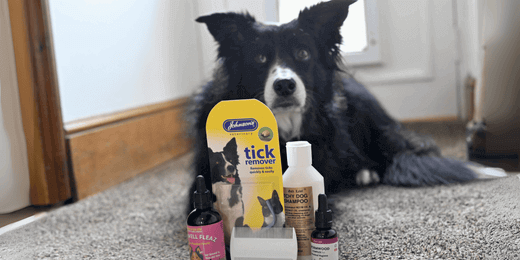
Fipronil - Are You Happy to Use it On Your Pet?
Fipronil in Our Eggs?
Read on to find out how Fipronil is used in common flea treatments.
We've all heard about the egg scandal making news headlines this week. But did you know that Fipronil is also used in common flea treatments such as Frontline, Fiprotec, Flevox and Johnson’s fipronil spot on.
Fipronil is a neurotoxin which means it causes damage to the nervous system and thus kills fleas, ticks, lice etc. However it is also considered toxic to fish and aquatic invertebrates, bees, and certain bird species. Because Fipronil degrades slowly once it is in the soil or the water, these animals are at particular risk for harmful levels of exposure and around the world, significant negative effects on agricultural and/or fishing activities have been attributed to the use of fipronil.
On our dogs and cats the Fipronil spreads over the body with the body oils in about 24 hours after application killing 100% of the fleas or ticks within 24-48 hours. Fleas and ticks are generally killed before they bite decreasing the risk of flea allergy dermatitis and tick-borne disease transmission.
Fipronil collects in the oils of the skin and hair and then is released over time (up to 1 month) from the hair onto the skin and hair. Fipronil stays on even if your pet gets wet from swimming or being bathed. So if you or your children are in the habit of burying your face in your pet’s fur or even just petting them you could be exposing yourself to fipronil. Indeed researchers at Murray State University found that low concentrations of fipronil are transferred to owners’ hands after five minutes of petting for up to four weeks after treatment.
Side effects of fipronil on dogs:
The most common reaction is skin irritation lasting a few days around the site where it is applied. However around the world vets have reported:
- Skin problems –This irritation can go beyond simple itching as the scratching can cause ulceration and open sores.
- Nervous system damage – Fipronil is a neurotoxin, causing damage to the fleas’ nervous system. It can have the same effect on your dog, causing symptoms such as convulsions, body twitches, loss of appetite, unsteady gait and other effects.
- Fipronil has been shown to cause thyroid cancer in dogs. Because of its carcinogenic qualities,it is important to thoroughly wash your hands with soap and warm water to adequately remove the product from your skin if you have applied it to your pet.
- Organ damage – Autopsies have shown an accumulation of fipronil in canine livers and kidneys, causing an increase in organ weight. Fipronil has also been shown to alter the levels of hormone secreted by the thyroid gland.
- Fipronil has also been shown to have an effect on a dog’s fertility. Its use has led to smaller litter size, difficulty in conception, decreased litter weights and increase in litter deaths.
Side effects of fipronil in people:
Humans can be exposed to Fipronil through contact with the skin or eyes, inhalation, or ingestion. This contact, if short-term in nature, may cause minor skin irritation. If accidentally ingested, the effect can be more serious, causing sweating, nausea, vomiting, headaches, stomach pain, dizziness, weakness, and even seizures. Generally, treatment is not required although there have been a handful of reported deaths where someone has deliberately drunk a quantity of fipronil. In the United States, Fipronil is classified as a possible human carcinogen.
Are you still happy to use it on your pets? Why not try more natural flea protection which will be safer for your pet, your family and the environment?
















